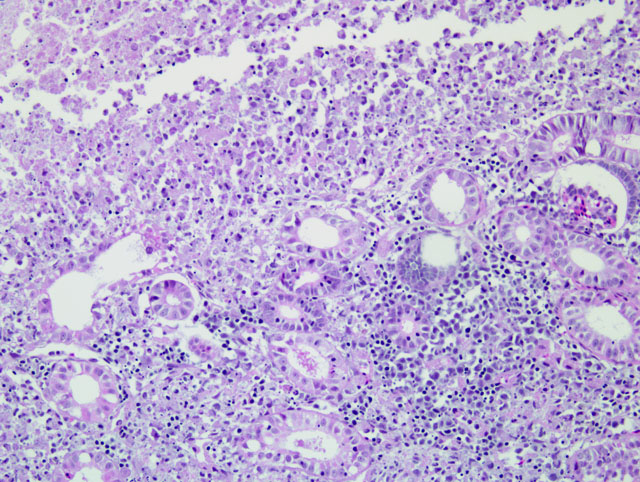Signalment:
Fingerlings (0+) (12.1 cm; 21.8 g) of Rainbow trout (
Oncorhynchus mykiss)Recorded mortality in previous 3 months: 7.9%, 20.7% and 4.3%. Clinical signs reported
(variable): exophthalmos, cutaneous ulcers and pale gills. No treatment attempted. Twelve fingerlings
submitted alive for necropsy.
Gross Description:
Exopthalmos, cutaneous ulcers and kidneys with multiple pale nodules (granulomas)
Histopathologic Description:
A large portion of the posterior kidney parenchyma is effaced by a
granulomatous infiltrate with areas of necrosis. There is loss of epithelial and hematopoietic elements.
Myriads of small bacilli can be seen in macrophages, but are better seen in Gram-stained sections. The
bacilli are Gram-positive and non-acid-Fast (Ziehl-Neelsen and Fite-Faraco).
Morphologic Diagnosis:
Kidney: Granulomatous nephritis with myriads of intrahistiocytic
Gram-positive bacilli, compatible with
Renibacterium salmoninarum (bacterial kidney disease /
BKD)
Lab Results:
Routine bacteriology (trypticase soy) on kidneys: negative. Numerous small Grampositive
rods observed in tissue smears.
Condition:
Renibacterium salmoniarum
Contributor Comment:
Based on the typical lesions and absence of growth in routine bacteriology of
kidneys, bacterial kidney disease (BKD) was diagnosed. Confirmation by bacteriology (special medium)
FA or ELISA was not done in this case since
Renibacterium salmoninarum was previously identified in
this particular facility; furthermore, histopathology coupled with negative results on routine bacteriology is
almost pathognomonic for BKD. The two bacterium that could be confused with
R. salmoninarum are
Carnobacterium (Lactobacillus) piscicola, the agent of pseudokidney disease (1, 2), and atypical
mycobacteria.Â
Carnobacterium piscicola rapidly grows at 30
oC on trypticase soy or brain-heart infusion
agar (1, 2), and the atypical mycobacteria are acid-fast and unevenly Gram-positive.
Renibacterium salmoninarum, the etiologic agent of bacterial kidney disease (BKD) is an important
pathogen of salmonids, including rainbow trout. Horizontal and vertical transmission occurs. BKD is a
chronic infection but stress can result in acute mortalities. There is no proven effective treatment.
Prevention relies on identification of infected broodstock (asymptomatic carriers).(1,2)
Gross lesions include dark discoloration of fish, exophthalmoses, pale gills, abdominal distension and
cutaneous vesicles/ulcers, but the most consistent and typical lesion is the presence of multiple whitish
nodules in the kidney (and occasionally in other viscera). Fibrinous pericarditis and large cavitations in
muscle can also be seen.(2) The typical microscopic lesion is pyogranulomatous to granulomatous
inflammation in the affected organ/tissue, with variable numbers of intra-histiocytic small Gram-positive
rods; necrosis can be seen, and is sometimes prominent. While histopathology gives a strong presumptive
diagnosis, confirmation relies on bacteriology, FA or ELISA. Bacteriology is not very practical, as
R.
salmoninarum is fastidious, very slow-growing and requires a non-commercially available medium. As
mentioned previously, the only differential diagnosis is pseudokidney disease caused by
Carnobacterium
(Lactobacillus) piscicola (1); this bacterium can be grown using routine bacteriologic techniques.
JPC Diagnosis:
Kidney, posterior: Nephritis, necrotizing, granulomatous, diffuse, severe, with myriad
intrahistiocytic bacteria, Rainbow trout (
Oncorhynchus mykiss), piscine
Conference Comment:
The contributor gives an excellent overview of
Renibacterium salmoniarum
infection.Â
Renibacterium salmoninarum is a gram-positive, nonmotile, non-acid-fast aerobic rod which is
frequently seen in pairs. This disease has only been reported in salmonids.(1) BKD generally affects
grown fish over 6 months of age, which makes it a particularly harmful and economically damaging
agent.(1) Several means of transmission have been reported and include water contamination, skin
abrasions, or eating of contaminated foodstuffs. Once
Renibacterium salmoninarum gains entry into a
salmonid, the bacteria are taken up by macrophages and proliferate inside their new host. It is unclear how
the bacteria avoid destruction within the marcophage. Stress is thought to be a precursor to clinical
disease.(1)
References:
1. Noga EJ: Bacterial kidney disease (problem 52), Mycobacteriosis (problem 53) and miscellaneous
systemic bacterial infections. In: Fish Disease: Diagnosis and Treatment, Noga EJ, 1st ed., pp. 153-162.
Iowa State University Press, 2000
2. Reimschuessel R, Ferguson HW: Kidney (Chapter Four). In: Systemic Pathology of Fish: A text and
atlas of normal tissues in teleosts and their responses in disease, Ferguson HW, 2nd ed., pp. 91-119, Scotian
Press, 2006
